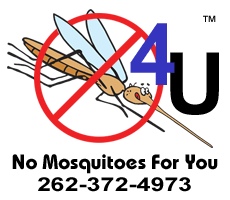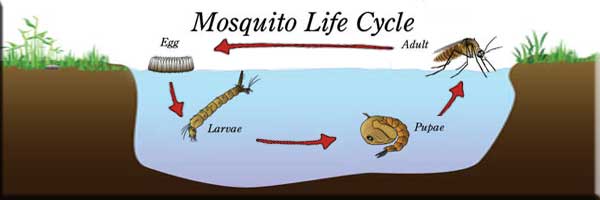There are many different species of mosquito in North America, but they all have one thing in common: they need water for their early life stages. All mosquitoes undergo the same four-stage life cycle: egg, larva, pupa, and adult. The second and third stages are aquatic. Depending on the particular species, the female mosquito lays her eggs, either individually or in attached groups called “rafts.” She places them either on the surface of still water, along its margins, in tree-holes, or areas prone to flooding via rain, tidal action, overflow, or seepage. Asian Tiger mosquitoes lay eggs only in manmade containers such as old tires, plant saucers, birdbaths and gutters, etc.
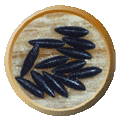
Egg shape and color varies with species, but the size is about 1/25" (1mm)
long. Approximately one hour after they’re laid, the eggs darken and become
opaque, effectively camouflaging them. In some species, the eggs may hatch
within only a few days of being laid, although the precise time varies with
temperature. But if the egg is laid out of water or is subject to drying, the
embryo inside it can remain dormant until ideal conditions for hatching are met, even
up to seven years. Once the egg hatches, the larval stage begins.

In most species the larvae feed on aquatic microorganisms. They stay
suspended just below the water surface most of the time, but can dive deeper
when alarmed. Because they swim in a characteristic S-shaped motion, mosquito
larvae are commonly called “wigglers” or “wrigglers.” The larval stage ranges
from about four to ten days, varying with species, water temperature, and food
availability.
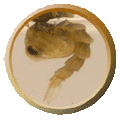
The pupa does not feed. Like the larva, it’s also sensitive to shadows,
ripples, and similar disturbances in the water. Because it’s physically active
and employs a tumbling motion to escape the deeper eater, the pupa is commonly
called a “tumbler.” After about 1 1/2-4 days (depending on temperature) the
pupa's skin splits along the back; the adult slowly struggles out and rests on
the water surface for a period of time to let its wings dry.
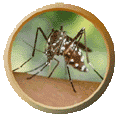
Usually the males emerge first and linger near the breeding sites, where they
wait for the females. Male mosquitoes usually live a mere 6 or 7 days. But with
ample food, females of some species can live for up to five months. A female may
survive only about two weeks during its most active summer period. To nourish
her developing eggs, the female mosquito needs blood. So she searches for a
blood meal from an animal. After each blood meal, the female mosquito lays her
eggs and the life cycle is renewed.
Outdoor Power Equipment Links Page
